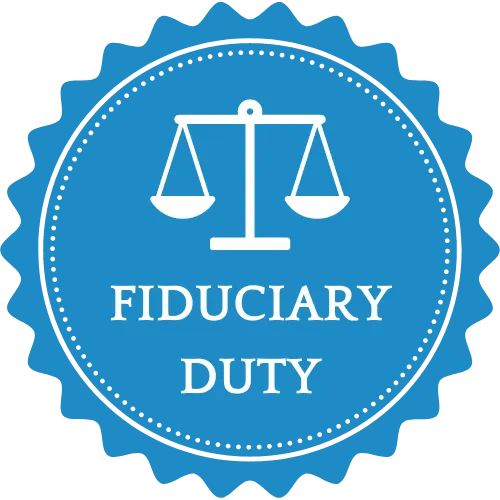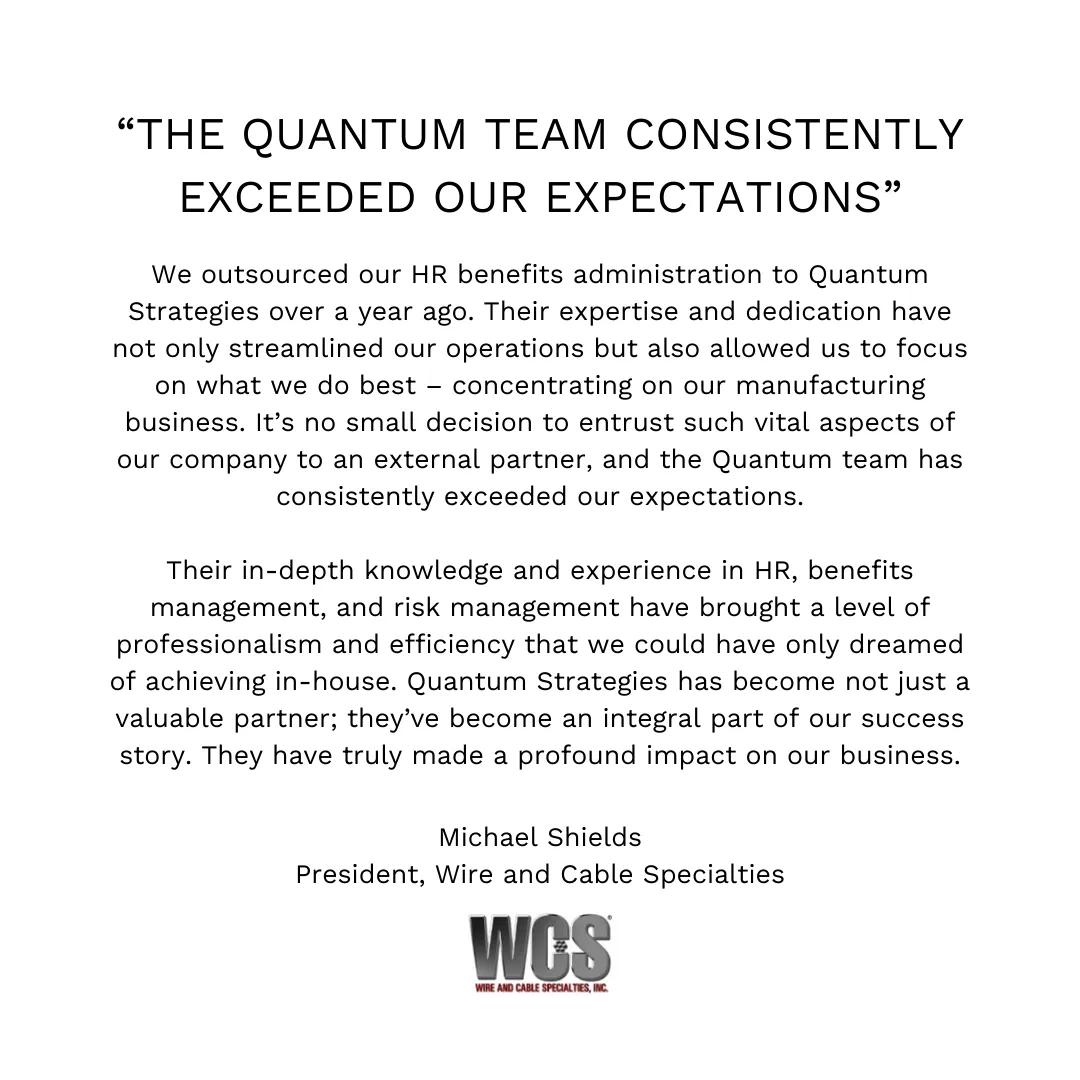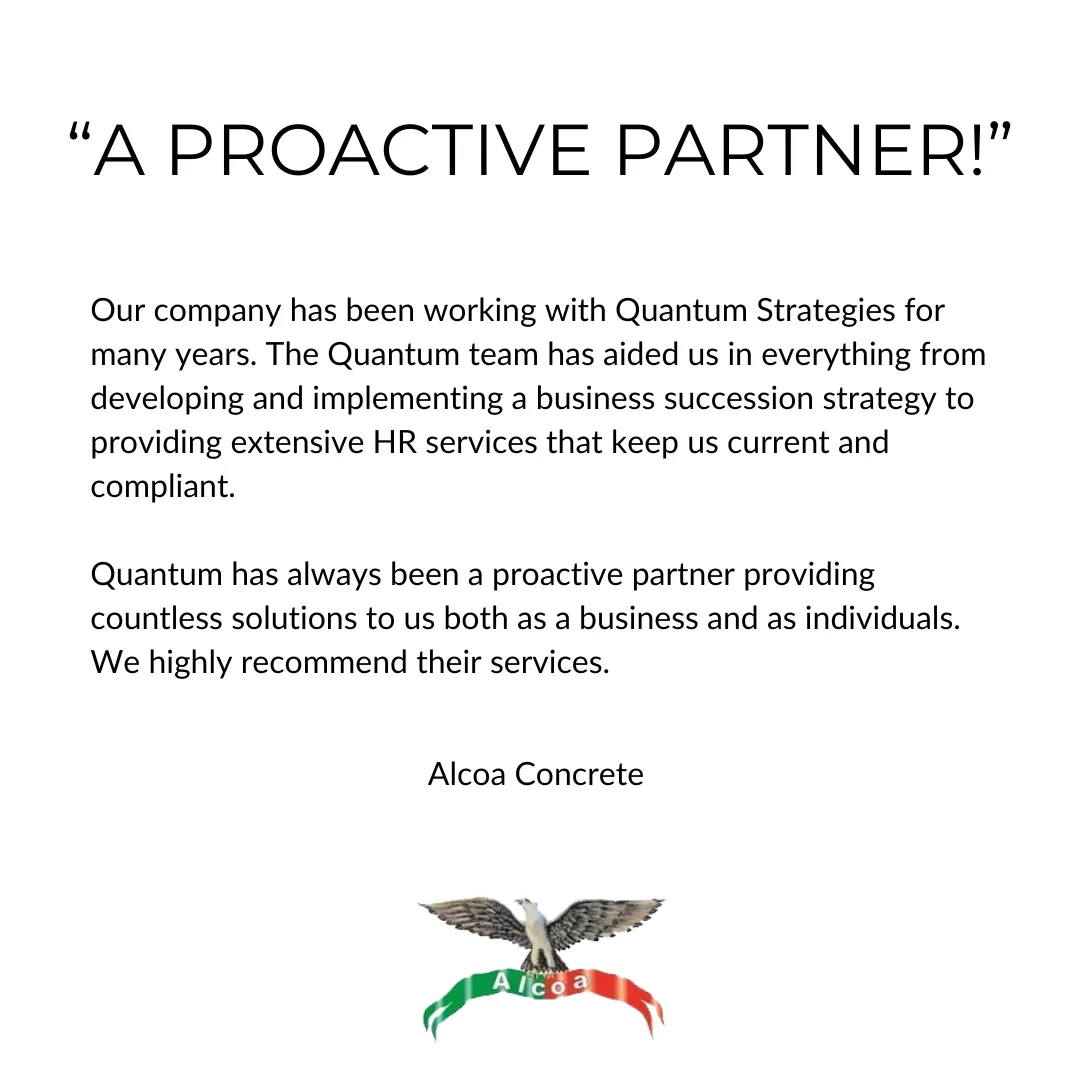Tailored HR Solutions as Unique as Your Business
Expert consulting and service to elevate your HR from a headache to a value driver.
Does Your HR Function Make the Grade?
Take our 5-minute quiz and evaluate the effectiveness of your HR function.

How We Help
We Focus on Your HR Needs,
So You Can Focus on Your Mission.
At Quantum Strategies, we understand that effective human resource management is the cornerstone of every successful business, regardless of size. Our mission is to provide tailored HR solutions that align perfectly with your unique business needs and growth stage.
Our Services
Navigating Change with Confidence: Quantum Expert HR Solutions
From Policy Assistance to Leadership Succession Planning, Quantum Strategies is Your Ultimate HR Resource to Solve Your Business Challenges.
HR Operational
Assessments
Unlock the full potential of your HR department. Our collaborative approach brings clarity and efficiency to your HR operations, providing a thorough analysis of your department's structure, costs, effectiveness, and needs.
Comprehensive Analysis: Detailed evaluation of your organization, workgroups, and individual roles for optimized efficiency.
Objective Insights: Receive a clear blueprint highlighting your HR department's strengths, weaknesses, and gaps.
Strategic Recommendations: Actionable plans focusing on technology utilization, communication enhancement, and leveraging department strengths.
HR Consulting and Managed Services
Tailored to align with your unique needs, our HR consulting and managed services enhance operational efficiency and effectiveness, allowing you to focus on your core mission while we optimize your HR investment.
Expert Supplemental Support: Strengthen your existing HR team with specialized expertise to navigate complex HR landscapes.
Personalized, Agile Solutions: Customized services for organizations with or without HR teams, adaptable to your specific requirements.
Goal-Oriented, Clear Communication: Delivering precise, actionable strategies that align with your organization’s goals and ensure successful execution.
Custom HRIS Design and Integration
Revolutionize your HR data management. Our team will evaluate your current human resources technology stack, offer recommendations, and then integrate your new and existing systems with our cutting-edge technology, ensuring seamless data flow and optimized operational efficiency.
Seamless Integration: Connect legacy systems with modern platforms for streamlined data management.
Tailored Design: Custom HRIS solutions uniquely crafted to meet your specific business needs.
Advanced Analytics: Leverage data-driven insights for strategic decision-making and operational excellence.
“Successfully steering through the specialized HR challenges within organizations of all kinds demands expert understanding, strategic planning, and precise implementation. With comprehensive knowledge of these challenges and the right solutions, your business can stay focused and successful in their vital missions.”
William J. Rizzo

Who we Are.
We Focus on Your HR Needs,
So You Can Focus on Your Mission.
At Quantum Strategies, we recognize that proficient management of human resources is fundamental to the success of any enterprise, irrespective of its scale. Our objective is to deliver customized human resource solutions that are in perfect harmony with your distinct business requirements and developmental phase.
Constant Improvement
Commitment to Customers
High Level Of Knowledge
Best Service You Can Get



Why Choose Us
A True Partner to Solve Your Most Complex HR Challenges.
Empowering HR Innovation and Compliance
Commitment to 100% Client Satisfaction
People-First Approach

Peace of Mind:
Handle ongoing compliance with ease

Employee Satisfaction:
Build a positive workplace with engaged employees

Strategic Confidence:
Drive strategy with advanced analytics

Leadership Development:
Equip your team with the tools to lead

2,245 +
Happy Clients

25 +
Years Of Experience

120 +
Professional Team
Testimonials
The Quantum Commitment - 100% CLIENT SATISFACTION!
At Quantum, we understand that your satisfaction matters most, and The Quantum Commitment is our way of putting that understanding into action. Experience the difference with a team that is dedicated to making your satisfaction the cornerstone of our service. Because when you choose Quantum, you choose excellence, reliability, and a commitment to exceeding your expectations every time.
Our Resources
Unveiling Proven Strategies and Insights.
Discover actionable tips, expert advice, and industry insights to fuel your journey towards success.

Fostering a Psychologically Safe Workspace
As we navigate the complexities of the post-pandemic world, the importance of mental health in the workplace has surged to unprecedented levels. According to research from the
American Psychological Association, 81% of employees are now actively seeking workplaces prioritizing mental well-being.
Key Challenges Faced by Human Resources in Nonprofit Organizations
The nonprofit sector brings its own set of specialized difficulties, especially in the area of human resources (HR). Although these difficulties may share some common ground with those in the for-profit industry, they possess unique characteristics that require special attention from nonprofit leaders.
FOUND THESE HELPFUL?
Explore Additional Articles and Resources In Our Blog

How to Cultivate Psychological Safety in the Workplace
High-performing organizations promote innovation and cooperation. Still, the psychological safety that underpins that achievement—psychological safety-is often overlooked. It is what empowers workers to voice their thoughts, share ideas, take responsibility for mistakes, and challenge social norms without concern for shame or punishment.
Creating psychological safety entails more than just making a welcoming office. It's about building an atmosphere where people are free to be audacious, honest, and accountable. By following established procedures, maintaining good communication, and employing strong leadership, companies can foster psychological safety through this guide. We will also define psychological safety and highlight its great importance.
Why Psychological Safety Matters
Psychological safety is the confidence that individuals can express their ideas, ask questions, exchange concepts, and acknowledge mistakes without fear of being penalized, mocked, or overlooked. Initially proposed by Harvard professor Amy Edmondson, the idea challenges the old view that professionalism requires perfection or silence. Conversely, psychological safety is about fostering authenticity—that is, enabling team members to be genuine, curious, and forthright.
A recent survey cited by SHRM found that workplaces with high levels of psychological safety report up to 27% higher employee engagement levels.
This cultural foundation has a significant impact on how companies grow and how teams operate.
QS2500’s HR Strategies services help organizations build the systems, leadership structures, and communication practices that make psychological safety possible. By aligning culture, processes, and people-management approaches, we support companies in creating workplaces where employees feel secure, valued, and empowered to contribute.
Key Reasons It Matters:
● Boosts Innovation: Employees in a psychologically safe environment are more likely to challenge the status quo or provide fresh ideas, even when they are unsure of the outcome. This openness to experimentation fosters the creation of an innovative culture, where continuous progress is the norm rather than the exception.
● Reduces Turnover: Feeling emotionally protected minimizes the likelihood of workers leaving their companies. All of which promote loyalty, they feel appreciated, heard, and regarded. People more devoted to the success of the firm are those who are not afraid to express themselves or speak out.
● Improves Mental Health: By reducing stress, worry, and emotional fatigue, psychological safety fosters a more pleasant workplace. When people can express their issues, seek help, or admit to being overwhelmed without worrying about repercussions, they are better equipped to handle workloads and maintain their well-being.
● Strengthens Team Performance: Boosts team performance by fostering psychological safety, making teams more resilient and tightly connected. Better open communication, responsibility for results, and faster bouncing back from failures characterize them. Teams can move toward their goals more quickly and effectively when trust is in place because trust enables speed.
Psychological safety connects independence, collaboration, and continuous development.

Key Principles for Cultivating Psychological Safety
A psychologically secure workplace requires steady leadership, open communication, and cultural support in addition to effective policies. Many companies claim to foster openness and respect, but genuine safety only emerges when trust is consistently modeled, nurtured, and sustained over time.
These core ideas should be incorporated into your team's culture to help create a climate where psychological safety can thrive.
1. Lead with Vulnerability
Leadership defines the tone. By admitting mistakes, accepting their limitations, or seeking help, managers and executives demonstrate that it is acceptable to be human at work. Leadership is not shown by vulnerability in the form of strategic honesty.
For example, a leader who says, "I don't have all the answers, but I would appreciate your feedback," shows transparency and humility. Besides motivating team members to share their ideas, this promotes among them a feeling of common ownership.
Weak leadership raises confidence and sets the expectation that everyone should be present, honest, and collaborative rather than perfect.
2. Encourage Curiosity and Feedback
A strong psychological setting welcomes comments and asks inquiries as standard. As a consequence of curiosity, fresh ideas and efficiency naturally grow when people believe they can inquire, "why" or "what if" without facing consequences.
Practical ways to encourage curiosity include:
● Ask often during team meetings, "What could we be missing? "
● Honoring and appreciating team members who address respectable yet challenging topics
● Setting up feedback systems that seem safe, such as confidential suggestion boxes or feedback applications,
● Reiterating that questioning is a sign of engagement, not a lack of skill
People start speaking up when they believe their voice is essential. This, over time, encourages a more open and natural dialogue across all corporate levels.
3. Foster Inclusivity and Empathy
A workplace that marginalizes or ignores some voices cannot have psychological safety. Teams must include a spectrum of perspectives to succeed, encompassing variations in background, communication styles, work ethics, and life experiences.
Leaders can cultivate empathy and inclusion by:
● In meetings, less vocal colleagues should be encouraged to share their feedback.
● Encouraging peer-to-peer help and active listening
● Understanding cultural differences in how people express their anxiety or opposition
● Display of emotional intelligence while receiving and giving feedback
Employees are more inclined to give their entire effort when they believe their ideas will be listened to freely without prejudice. Empathy—both from leaders and from colleagues—helps to connect diversity and belonging.
4. Maintain Transparency and Clarity
Uncertainty often causes fear, which erodes trust. Even in the face of change, team members in firms that prioritize clear, consistent, and honest communication feel more secure.
Transparency should comprise:
● Explaining the "why" behind corporate decisions, not just the "what," clearly.
● Offering rapid updates throughout reorganizations or shifts
● Setting standards for performance, deliverables, and key performance indicators
● Allowing employees the possibility to ask questions for clarity
Even if they don't have all the answers, honesty is vital for individuals to feel safe. By reducing gossip, misunderstanding, and misalignments, transparency and leadership help to build trust and clarity.
Best Practices to Build Psychological Safety
Building a culture of safety requires consistent behaviors, systems, and reinforcements. Here are 10 practical actions any organization can take:
1. Normalize Mistakes as Learning Opportunities
Instead of penalizing errors, debrief them. Ask: What went wrong? What can we learn? This approach encourages accountability without blame.
2. Invite Candid Dialogue
Create formal and informal spaces for open communication:
● Weekly check-ins
● "Ask Me Anything" (AMA) sessions with leadership
● Anonymous feedback tools
3. Celebrate Effort, Not Just Results
Recognize employees who take initiative, even if outcomes aren't perfect. Reinforce that trying matters, not just succeeding.
4. Hold Regular Retrospectives
In project-based or cross-functional teams, use retrospectives to ask:
● What went well?
● What could be improved?
● What should we try next time?
These rituals foster continuous learning and shared responsibility.
5. Acknowledge Individual Contributions
Use shouts, peer recognition, or team highlights to confirm the value of every voice, especially those of underprivileged groups or less vocal team members.
6. Train Leaders in Active Listening
Listening isn't just hearing—it's processing, reflecting, and responding. Encourage managers to:
● Use open-ended questions
● Paraphrase what's heard.
● Show nonverbal engagement (eye contact, nodding)
7. Use Psychological Safety Surveys
Tools like Amy Edmondson's Psychological Safety Scale or brief pulse surveys can track progress.
Sample questions:
● I feel safe taking risks on my team.
● My manager values my input.
● Mistakes are treated fairly.
8. Set Team Norms
Develop agreements like:
● "One mic at a time."
● "Challenge ideas, not people."
● "Mistakes are learning moments."
These micro-rules create macro-impact.
9. Provide Clear Boundaries
More structure ironically improves safety. Clearly define your expectations, including deadlines, duties, and the authority to make decisions. Knowing what to expect makes people feel secure.
10. Model Respect in Conflict
Healthy disagreement is a sign of respect; disrespect is not. Encourage teams that disagreement is okay and model effective, rather than personal, conflict resolution.
Overcoming Common Barriers
Despite good intentions, many teams struggle to build psychological safety due to ingrained habits or cultural barriers. Here's how to identify and break them down:
Barrier 1: Fear of Speaking Up
Many employees, especially new hires or those from marginalized backgrounds, may hesitate to speak up. Address this by:
● Directly inviting their input
● Following up on feedback to show it matters
● Showing appreciation when concerns are raised
Barrier 2: Competitive or Political Culture
When employees fear being "outshone" or undermined, collaboration suffers. Shift focus from individual performance to team success and recognize collaboration in performance reviews.
Barrier 3: Overemphasis on Perfection
Cultures that demand flawless execution discourage risk-taking. Replace "get it right the first time" with "let's learn as we go."
Barrier 4: No Accountability for Toxic Behavior
Psychological safety is undermined when toxic behaviors go unchecked. Hold everyone accountable—regardless of title—for respectful communication.
Measuring Psychological Safety
You can't improve what you don't measure. Psychological safety, while emotional and cultural, can be measured using a combination of qualitative and quantitative tools.
1. Surveys
Regular surveys are one of the most effective tools to measure how psychologically safe employees feel. These assessments don't need to be lengthy or complex, but they should ask targeted questions that explore themes like trust, openness, and perceived support.
Common approaches include:
● A short series of recurring questions that track perceptions over time
● Pulse check surveys are distributed quarterly or monthly to assess current sentiment
● Anonymous team-based assessments to encourage honest responses
Progress in psychological safety is often gradual, so consistency is key.
2. Engagement Metrics
Another way to measure psychological safety is by observing behavior patterns across the organization. Teams that feel safe tend to participate more fully and voluntarily.
Watch for signs such as:
● The number of new ideas shared in meetings or brainstorming sessions
● Frequency and depth of upward feedback
● Participation rates in retrospectives, optional one-on-ones, or team discussions
● Voluntary engagement in peer coaching or internal initiatives
Low participation may signal that employees don't feel comfortable speaking up, especially if accompanied by other warning signs, such as declining morale or a lack of innovation.
3. Feedback Quality
Psychological safety isn't just about who's speaking up, but how they're doing it. A psychologically safe workplace supports honest, constructive, and solutions-oriented feedback.
Ask yourself:
● Are feedback conversations open and respectful, or cautious and surface-level?
● Do team members share concerns early, or wait until things escalate?
● Are tough conversations happening behind closed doors, or avoided altogether?
The depth, frequency, and tone of feedback across teams can act as a barometer for cultural health. High-performing teams don't avoid conflict—they approach it with care, context, and confidence.
4. Leader Behavior Audits
Leadership behavior has a direct impact on psychological safety. Leaders shape team dynamics through their words, body language, tone, and decision-making style. To ensure they're creating the right environment, organizations should implement behavioral reviews and accountability structures.
Consider asking:
● Do managers actively listen, or dominate conversations?
● Are they modeling vulnerability by admitting mistakes and asking for input?
● Do they create space for a variety of perspectives to be heard?
These behaviors can be assessed through peer feedback, one-on-one reflections, or 360-degree reviews tailored to psychological safety indicators. Without leadership modeling safety, cultural change won't take hold.

Summary
Psychological safety isn't a perk—it's a foundational element of a thriving workplace. Teams that feel safe perform better, innovate more, and build stronger cultures of trust and accountability.
Whether you're leading a team or shaping organizational policy, start small:
● Share your challenges.
● Ask your team what would make them feel safer to speak up.
● Build rituals that reinforce reflection and learning.
As safety grows, so performs. And the companies that lead with trust and humanity will continue to attract, retain, and elevate the best talent. To support psychological safety at every level of your organization, our HR consulting team provides strategies that foster openness, collaboration, and employee well-being.
Want to know how psychologically safe your team feels? Start with a quick pulse survey or a team discussion about "what safety means to us." Small steps lead to lasting culture shifts—and your team will thank you for it.
Ready to create a workplace where your people feel safe, heard, and empowered?
Connect with Quantum Strategies HR today to explore how our Employee Engagement Centre (EEC) helps foster psychological safety, boost collaboration, and strengthen team performance through smarter HR solutions.
Connect
Keep Up with Our Latest News and Insights
Subscribe to Quantum Strategies' latest updates and insights.
Office: Philadelphia, PA | Glen Mills, PA | Washington, DC
Call 610.624.1770
Email: info@QS2500.com
Site: www.QS2500.com






